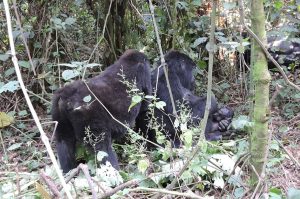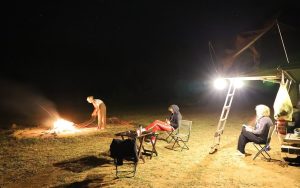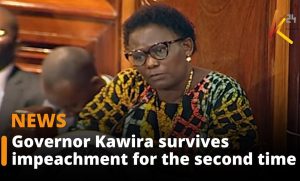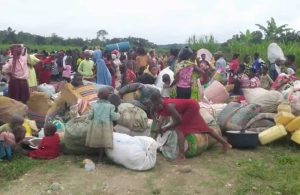Burundi is a small country like Rwanda and has a history of ethnic relations close to those in Rwanda.
EricThe problems leading up to the genocides of 1965, 1972, 1988 and 1993 can be traced to Tutsi fear brought about by democracy that changed things in favor of Hutu in the Great Lakes region including in southwest Uganda.
The September 1961 pre-independence elections were won by the moderate multi-ethnic party UPRONA led by the eldest son of the king Prince (ganua) Louis Rwagasore defeating the conservative party. Rwagasore became prime minister. In October 1961 he was gunned down by a Greek assassin hired by Rwagasore’s opponents who lost the election. His death split the party into ethnic factions.
In 1965 the country held the first post-independence elections which were overwhelmingly won by Hutus. But the king appointed a Tutsi as prime minister. The Hutu protested and Hutu soldiers attempted a coup creating a pretext for the Tutsi dominated military to commit genocide and get rid of Hutu threat to their future.
Alison Des Forges wrote that “The [Tutsi-dominated] army supported by civilian Tutsi ‘self-defense’ responded by killing between 2,500 and 5,000 Hutu.
After the attempted coup, a first generation of Hutu leaders was executed, and the army, now purged of Hutu officers, was on its own way to becoming a force virtually all Tutsi among its commanders and largely Tutsi in its ranks” (Current History May 1994).
What precipitated the 1972 genocide has remained controversial. Tutsi claim that Hutu attempted a military coup. Hutu claim it was engineered by Tutsi to get rid of them. Be that as it may, the fact of the matter is that the Tutsi in Burundi feared that a social revolution similar to what happened in Rwanda in 1959 could occur in Burundi as well. So they were determined to take preventive measures, some people argue.
The Tutsi dominated military committed genocide against the Hutu people. The target was the educated all the way to primary school children and all rich Hutu. The perpetrators of the genocide were for the most part drawn from the ruling Tutsi minority. The killings were conducted by the military assisted by the youth wing of the political party. Much of the genocide was planned by then minister of foreign affairs, assisted by then minister of interior and justice and the executive secretary of the ruling party. All three were of Hima origin [Hima are a clan of Tutsi]. And the latter two held positions in the army. The genocide targeted educated all the way down to primary school and wealthy Hutus which paved the way for the emergence of Tutsi ethnocracy. “For the next 20 years, all positions of influence and responsibility in the government, the administration, the army and the economy were in Tutsi hands” (Samuel Totten et al., 2004).
Alison Des Forges added that “The army responded with a repression so brutal to qualify as genocide. Over several months some 100,000 Hutu were killed, [estimates range from 100,000 to 300,000 as shown below] including virtually all with higher education; leaders and potential leaders and those still students in institutions of higher learning; leaders and potential leaders were targeted in an effort to ensure continued Tutsi domination. The army employed some new methods, such as helicopter attacks, but resorted once again to using civilian bands to extend its range, sometimes inciting them in radio broadcasts to attack Hutu in their vicinity. As the extent of the carnage became clear, several hundred thousand Hutu fled the country”(Current History May 1994).
The genocide took place between May and August 1972 with military help from Mobutu of Zaire and the country was placed under martial law. By the time genocide was over, what is important is not so much how many Hutu were killed but that almost every educated element was either dead or in exile. Estimated of those killed vary. Lemarchand gives an estimate of between 100,000 and 150,000. Hutus claim that the number was 300,000 dead. “However much one can disagree about the scale of the massacre, that it reflects a planned annihilation is hardly in doubt” (Samuel Totten et al., 2004).
Many methods were used to carry out the genocide. One of them was described this way: “During the genocide of Hutus by Tutsis in Burundi in 1972 … a perpetrator explained: Several techniques, several, several. One can gather two thousand persons in a house – in a prison, let us say. There are some halls which are large. The house is locked. The men are left there for fifteen days without eating, without drinking. Then one opens. One finds cadavers. Not beaten, not anything. Dead”(Steven Pinker 2011).
The world either kept silent or expressed solidarity with the Tutsi government of Burundi about the 1972 genocide. Lemarchand writes “The unwillingness of the international community to see through the humbug of official media and take heed of the many warning signs preceding the slaughter, all wrenchingly clear, is little short of astonishing. Perhaps the most surreal of all international responses to the slaughter came from the Organization of African Unity (OAU) – now the African Union (AU) – on May 22, 1972 during the visit to Bujumbura by the OAU Secretary-General Diallo Telli. ‘The OAU’, said Telli, ‘being essentially an organization based on solidarity, my presence here in Bujumbura signifies the total solidarity of the [OAU] Secretariat, with the President of Burundi, and with the government and the fraternal people of Burundi'”(Samuel Totten et al., 2004).
“To take full measure of western indifference, one can do no better than quote from the surprisingly guarded letter of the diplomatic corps delivered to President Micombero on May 30, at the initiative of the papal nuncio: ‘As true friends of Burundi we have followed with anguish and concern the events of the last few weeks. We are thus comforted by your appointment of groups of ‘wise men’ to pacify the country, and by the orders that you have given to repress the arbitrary actions of individuals and groups, and acts of private vengeance and excesses of authority”. Unsurprisingly, the only member of the diplomatic corps who refused to sign the letter, presumably objecting to its offensive wording was the French ambassador.
“Hardly more edifying was the response of the UN Secretary-General, Kurt Waldheim, to the carnage. … Waldheim expressed his ‘fervent hopes that peace, harmony, and stability can be brought about successfully and speedily, that Burundi will thereby achieve the goals of social progress, better standards of living and other ideals and principles set forth in the UN Charter. … In 1972, as in 1994, the UN sat on its hands as hundreds of thousands of innocent Africans were being slaughtered”( Samuel Totten et al., 2004).
As in Rwanda 1994 genocide, there were sufficient warnings of an impending massacre of innocent Hutu by Tutsi in 1972 in Burundi but none took heed.
In June 1993, Melchior Ndadaye, a Hutu and young banker won the presidential elections with 65 percent of the votes cast. Although the October 1961 coup failed, Ndadaye was dead together with other senior officials including the constitutionally designated successor speaker of parliament. Allegations are that the failed attempted coup was planned by Museveni and Kagame in Entebbe Uganda. The day following the death of the president “Tutsi soldiers and police descended on communities where Tutsi had been threatened or attacked, as well as on others where there had been no trouble. They used unnecessary force against Hutu, including both those armed with spears, machetes and clubs and those who made no attempt to defend themselves.
In some communities soldiers used helicopters, machine guns and incendiary grenades, as they had in Ntege and Marangara in 1988. Elsewhere they arrived in armored vehicles and randomly strafed homes and other buildings. Soldiers and police collaborated in some attacks with civilians including bands of high school students”(Current History May 1994).
Since 1994 Rwanda genocide, Tutsi have projected themselves as a minority victimized by the majority Hutu. The record shows that since the 15th century when the Nilotic Tutsi from South Sudan began interacting with Bantu from the Cameroon/Nigeria border, it is Tutsi that have committed atrocities including selling Bantu as slaves. Tutsi monopoly of the military which they have used to defeat, dispossess and impoverish Hutu and Bairu of southwest Uganda has turned them into aggressors, not victims. Bantu who were wealthy and healthy before the arrival of Tutsi were turned into serfs subsequently reminiscent of medieval Europe.
The brutality of Tutsi towards Hutu was demonstrated without shame during an interview when Kagame was attending the Commonwealth Summit in Uganda. Kagame admitted that for four years his troops had done a thorough job of eliminating genocidaires and interahamwe in eastern DRC.
The question to ask is this: Since Hutu genocidaires and Interrahamwe look exactly alike other Hutu, live together and dress alike, and were no longer carrying machetes and guns how did Kagame troops manage to isolate genocidaires and Interahamwe from the rest of Congo and Rwanda Hutu before genocidaires and interahamwe were thoroughly eliminated? Kagame should be asked or forced to answer this question.
One more thing: How come in the Great Lakes region which includes Kenya and Tanzania endemic troubles are found in areas where Tutsi live in eastern DRC, Burundi, Rwanda and Uganda? Tutsi cause trouble because they have insisted they were born to rule over others and they will achieve it by force of arms, a network of spies using Tutsi women where necessary and political intrigue.
So far they have had massive support from some powerful western countries that are protecting them at home and abroad especially at the United Nations where Rwanda now is a member of the Security Council and Uganda may be elected president of the General Assembly for the session starting this September in 2013. This external orientation is diverting mushrooming domestic problems in both countries. In Rwanda Tutsi and Hutu don’t like each other; Tutsi who stayed in Rwanda are not happy with Tutsi refugees who came back and took most of the good jobs and other benefits; and French-speaking Tutsi and English-speaking Tutsi who are jockeying for positions and other benefits. So the situation is fluid there as in Uganda where NRM is cracking, the military is beginning to crack and cracks have been reported in the police.
Rosy average economic growth and per capita income figures for Rwanda and Uganda captured in the 2013 Human Development report (HDR) mask wide disparities in income distribution and leave out of the report poverty and its offshoots of hunger, unemployment, disease, urban slums, alcoholism and drug abuse, domestic violence and crime and rapidly deteriorating environment particularly in Uganda. Democracy at gun point has become unsustainable. Museveni and Kagame have gone beyond rebranding. It’s time to have new leaders and we urge our development partners to help level the playing field.
Revolutions in France, Russia, Mexico and Ethiopia took place in conditions similar to those in Uganda today. We should learn from these lessons to prevent a repeat instead of ignoring them. We believe all people in the region should live together in peace, security and harmony and the region has enough to go round if justice prevails.




